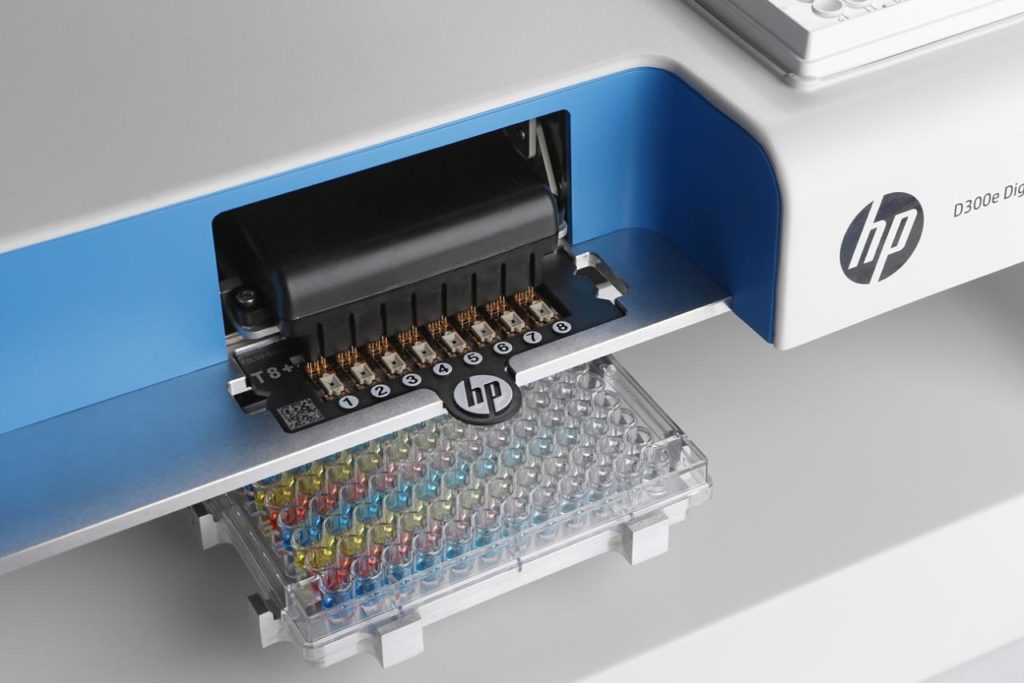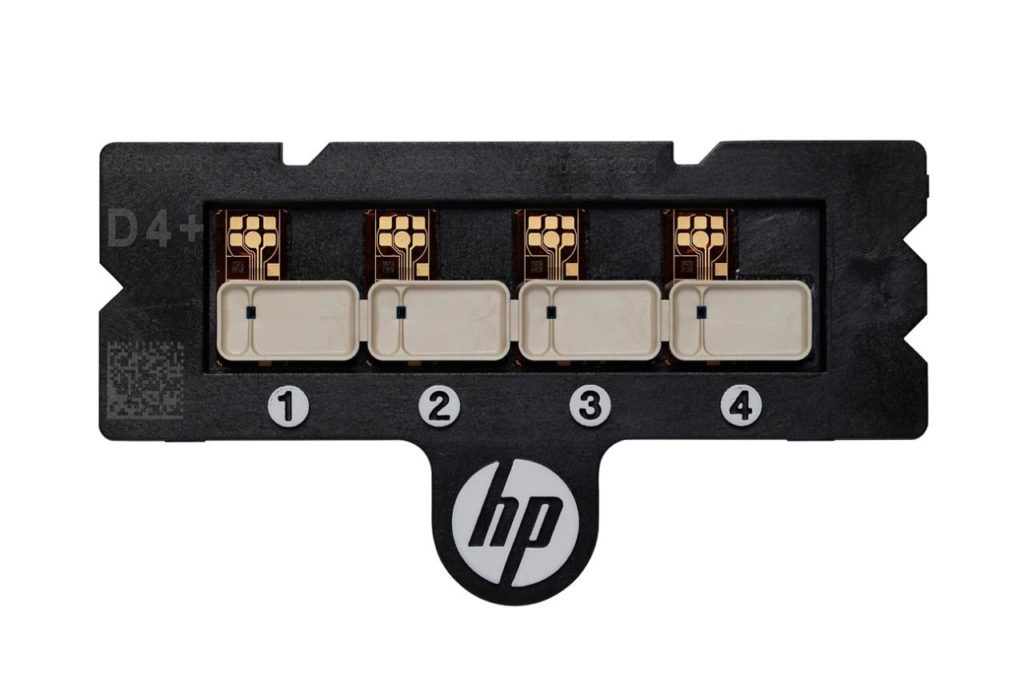It has been years in the making, but finally, we know more about HP’s highly awaited bioprinting system. In the last years, HP has moved heavily into the research of microfluidics and bioprinting technology, leading to the development of their first bioprinter, called D300e BioPrinter, which was recently used by a team of scientists at the University of California San Fransisco (UCSF) Medical Center research laboratory in the fight against cancer.
The result of years of research and development, the BioPrinter was created through a collaboration between HP’s Specialty Printing Systems (SPS), spearheaded by Annette Friskopp; the Microfluidics Technology and Operations (MTO) teams; and made in partnership with Tecan, a global provider of automated laboratory instruments and solutions. The D300e is a digital dispenser that uses inkjet printing technology and is the company’s first life science application in this domain, enabling automated laboratory dispensing to print pharmaceutical samples instead of ink.
It requires almost no set-up time and uses disposable dispense heads to minimize dead volumes and virtually eliminate the risk of cross-contamination, offering high quality, low volume dispensing for a wide range of applications. According to Tecan, the device eliminates up to six steps from the workflow for better speed, simplicity, efficiency, and productivity. Best of all, it operates with intuitive software that guides users through every operation, minimizing training times and increasing accessibility. It has built-in wizards that simplify the creation and execution of complex plate layouts and highlighted loading guides to identify the correct pipetting location for faster, simpler and more accurate operation.
The Director of Surgical Oncology Research Lab at UCSF, David Donner, leads a team that focuses on liver malignancies, particularly metastatic colorectal cancer that has metastasized into the liver and intrahepatic cholangiocarcinoma, and recently used the D300e’s automated lab dispensing to print pharmaceutical samples instead of ink to advance their work more efficiently.
“One of the challenges we face when studying these cancers is that, being in a clinical department, we are not interested in animal models and styding the characteristic of these particular cancer for decades, we’ve got patients who are in a hosptial now who need attention. So what we need to do is find drugs and drug combinations for each individual patient,” said Donner.
Donner went on to say that “personalized medicine is what we do: taking each patient’s specimen and isolating small spheroid groups called organoids, to then robotically load ultra low adherent tissue culture plates with individual orgaoinds. We want to screen libraries of drugs against each individual patient’s tumor specimen and that’s where the D300e comes in, allowing us to rapidly test libraries of drugs against each patient’s organoid and once we find an individual drug that seems to work well, we use that drug as a pole and rescreen our library to find something that will work well in conjunction with it. We are interested in synergies or at least additivities, because we want to kill the tumor and keep ahead of it. We want quality of life. We want cures. And the D300e is facilitating that.”
Donner, who is also a professor in the Division of General Surgery at UCSF, stated that his lab, like many others, understands that the automation and robots that are needed to advance quicker, are very expensive, instead, the D300e isn’t. It is affordable for an academic research laboratory and has a small footprint since it fits right into the corner of a desk.
“All of the problems that we face with robotics, are overcome by using the D300e in conjunction with other robots that allows us to relatively rapidly loading organoids into tissue culture plates so that the D300e can also dispense drugs across those loaded organoids,” suggested the expert.
But it is not just UCSF using HP’s new bioprinter, labs and pharmaceutical companies all over the world already have it, including the Centers for Disease Control and Prevention (CDC) in the Antibiotic Resistance (AR) Lab Network, to perform antimicrobial susceptibility testing for health departments and hospitals nationwide.
According to the CDC, antibiotic resistance is one of the biggest public health challenges of our time. In the US alone, at least 2.8 million people get an antibiotic-resistant infection every year, and more than 35,000 people die. The CDC considers that fighting this threat is a public health priority that requires a collaborative global approach across sectors.
“It’s very exciting to see our inkjet printing technology support the CDC’s latest initiatives to help save lives,” said Todd Gustafson, President of HP Federal and Head of US Public Sector. “For over 75 years, HP has been enabling Federal organizations with technology that bring their missions to life. We’re honored to support the CDC in coming one step closer to more accelerated testing.”
For Jean Patel, microbiologist and science lead for CDC’s AR Laboratory Network, “bacteria continuously develop new ways to resist antibiotics.” The expert indicated that “once a drug is approved for use, the countdown begins until resistance emerges. In fact, resistance has even been detected before FDA approval.” He claims that to save lives and protect people, it is vital to make technology accessible to hospital labs nationwide.
“We hope this pilot will help ensure our newest drugs last longer and put gold-standard lab results in healthcare providers’ hands faster.”
Both CDC and HP are making the D300e technology accessible to hospital labs nationwide. This is why Tuan Tran, President of HP Imaging, Printing and Solutions, considers that “applying technology in new and impactful ways is core to what we do at HP. The CDC’s use of HP Bioprinters epitomizes the power of print – pushing the boundaries of innovation while making the world safer, cleaner and healthier for all.”
“Through our pilot with the CDC and working with public health labs in the US and worldwide, we hope to help CDC in its efforts to change the way the healthcare industry tests antimicrobial resistance to help people with the most critical health needs. We are honored to collaborate with the CDC and others in our commitment to innovate solutions that can enhance drug susceptibility testing, ultimately improving patient health and combating antibiotic resistance,” said Friskopp, Vice President and General Manager, Specialty Printing Systems, HP.
For many companies, the hard part is figuring how to enter and dominate a market. HP’s ink business dominated the market for decades, now the firm is looking into a different field, but with their deep-rooted know how, strong resources and solid marketing strategy, they have a good base for their novel product. The D300e BioPrinter could become as trendy in the field of biotechnology as the HP Deskjet printer, the world’s top-selling printer for 20 years. This new move by HP was well received by the scientific community, and we expect to hear more about what the machine can do for researchers everywhere.
(Images: HP)
Subscribe to Our Email Newsletter
Stay up-to-date on all the latest news from the 3D printing industry and receive information and offers from third party vendors.
You May Also Like
Profiling a Construction 3D Printing Pioneer: US Army Corps of Engineers’ Megan Kreiger
The world of construction 3D printing is still so new that the true experts can probably be counted on two hands. Among them is Megan Kreiger, Portfolio Manager of Additive...
US Army Corps of Engineers Taps Lincoln Electric & Eaton for Largest 3D Printed US Civil Works Part
The Soo Locks sit on the US-Canadian border, enabling maritime travel between Lake Superior and Lake Huron, from which ships can reach the rest of the Great Lakes. Crafts carrying...
Construction 3D Printing CEO Reflects on Being Female in Construction
Natalie Wadley, CEO of ChangeMaker3D, could hear the words of her daughter sitting next to her resounding in her head. “Mum, MUM, you’ve won!” Wadley had just won the prestigious...
1Print to Commercialize 3D Printed Coastal Resilience Solutions
1Print, a company that specializes in deploying additive construction (AC) for infrastructure projects, has entered an agreement with the University of Miami (UM) to accelerate commercialization of the SEAHIVE shoreline...

































